
The all-new Rogue (T32) is totally redesigned for 2014. It features bold new styling and for the first time offers optional 3-row/7-passenger seating. Nissan engineers also concentrated on reducing noise, vibration and harshness and enhancing dynamic performance and ride comfort.
The Rogue’s new unibody structure is based on Nissan/Renault Common Module Family (CMF) platform. The new Rogue has a stylish, muscular exterior, roomy and inviting interior, and easily configurable passenger/cargo space and features. It is available in three trim levels and in either front-wheel or all-wheel drive. There are five option packages for the three well-equipped models; three f or SV and one each for S and SL.
- S: Family Package
- SV: Family Package, Moonroof Package, Premium Package
- SL: Premium Package
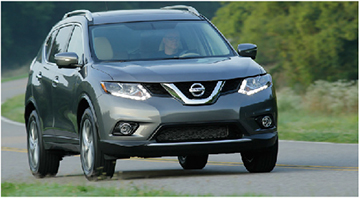
ENGINE
Every 2014 Nissan Rogue is equipped with a responsive, large-displacement, DOHC, 16-valve QR25DE 2.5-liter 4-cylinder engine rated at 170 horsepower at 6000 rpm and 175 lb-ft of torque at 4400 rpm. The design changes for the QR25DE help enhance performance, improve fuel economy and reduce emissions. The Rogue features Twin Variable Timing Control (VTC) and an Intake Manifold Runner Control Valve (Tumble Control Valve). The exhaust valve timing control mechanism hydraulically controls cam phases continuously with the fixed operating angle of the exhaust valve. The ECM receives signals such as crankshaft position, camshaft position, engine speed and engine oil temperature. Then, the ECM sends ON or OFF pulse duty signals to the exhaust valve timing (EVT) control solenoid valve depending on driving status. The longer pulse width duty signal retards the valve angle. The shorter pulse width advances valve angle. When ON and OFF pulse widths become equal, the solenoid valve stops oil pressure flow to fix the exhaust valve angle at the control position. This makes it possible to control the shut or open timing of the exhaust valve to increase engine torque and output in a range of high engine speeds.
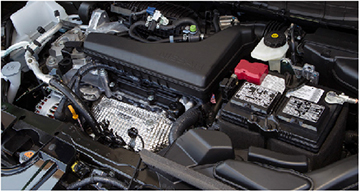
VARIABLE EXHAUST VALVE TIMING CONTROL
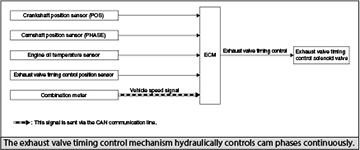
INTAKE MANIFOLD RUNNER CONTROL VALVE (TUMBLE CONTROL VALVE)
The Intake Manifold Runner Control Valve is located downstream of the throttle body and used to improve fuel economy and reduce emissions. The Intake Manifold Runner Control Valve assembly includes valve portions located in the intake passage for each cylinder. The four tumble control valves are essentially a butterfly valve added in each intake runner near the cylinder head. The tumble control valve promotes proper atomization of the fuel due to the turbulence caused by the tumble control valve.
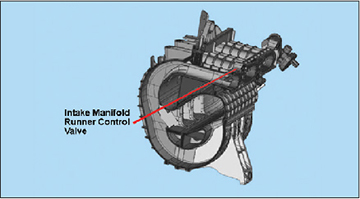
Intermediate Lock (Intake VTC)
During engine start-up and during cold engine operation, two spring-loaded intermediate keys lock the control vane in the intermediate position.
When the engine coolant reaches normal operating temperature, oil pressure from the oil switching valve overcomes the spring pressure and the lock keys are disengaged. The control vane is free to move the camshaft to the advance or retard phase, based on oil pressure from the oil control.
CONSULT-III plus can be used to verify that the camshafts are kept in the intermediate position to allow the engine to start and achieve normal operating temperature before variable valve timing occurs.
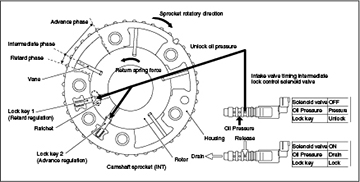
DRIVETRAIN
The new Rogue is available as Front-Wheel Drive (FWD) or Intuitive All-Wheel Drive (AWD). The location of all drivetrain components at the front of the vehicle helps to maximize interior space. With FWD, the combined weight of the engine and transmission over the drive-wheels helps improve traction on wet, snow-covered or slippery surfaces.
Intuitive All-Wheel Drive
Intuitive AWD optimizes power distribution for improved traction under various road conditions. Under normal road conditions, the system operates in FWD for improved fuel efficiency. AWD automatically directs up to 50 percent of the available power to the rear axle for reduced-slip start-ups. The Intuitive AWD system works in conjunction with the Vehicle Dynamic Control system to adjust the torque split between the front and rear wheels to help the driver maintain cornering control.
Xtronic CVT®
The Rogue engine is matched to an advanced next-generation Xtronic CVT® with standard Sport Mode switch drive configuration. The CVT (RE0F10D) is designed for a reduction in friction loss (versus the previous generation). It achieves this with highly accurate line pressure control and secondary pressure control that reduces friction for improvement of fuel economy. The new CVT has been equipped with an new belt and pulley system to help improve oil churning friction. The new CVT features new control logic and expanded gear ratio coverage that help reduce noise and fuel consumption while improving drivability and responsiveness compared to the previous generation CVT in the S35 Rogue Select. The new CVT is equipped with a down-sized, more compact oil pump that uses Nissan NS-3 Low Viscosity Oil.
Line Pressure Control
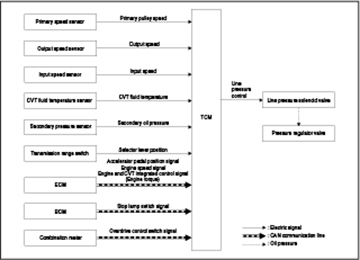
Secondary Pressure Feedback Control
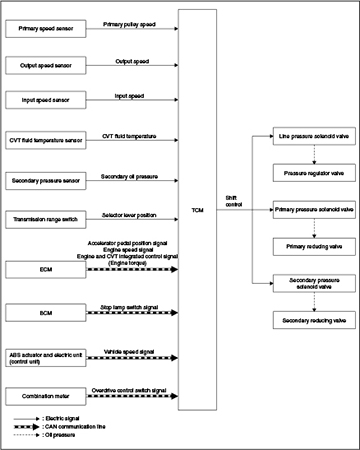
SUSPENSION
The 2014 Rogue comes standard with 4-wheel independent suspension designed to help absorb the bumps and offer quicker more comfortable road response.
The Rogue is equipped with an independent front struts suspension with coil springs and an independent rear multi-link suspension, both with stabilizer bars. Twin-tube, dual-pass SACHS shock absorbers help to maintain the Rogue’s ride comfort over varying road surfaces. The suspension is attached to a subframe that is joined to the body by rubber bushings.
Electric Power-assisted Steering
The Electric Power-assisted Steering (EPS) is standard on the new Rogue. The EPS system design for the new Rogue has been improved with new EPS logic for high stability, tracing performance and less body motion so that it adjusts better to the speed of the vehicle to offer more feedback to the driver than previous systems.
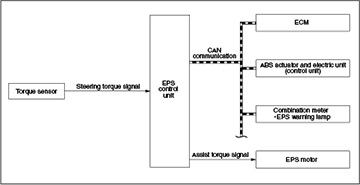
The EPS control unit performs an arithmetical computation from data received from the steering torque signal from the torque sensor and the vehicle speed sensor signal. It uses this input to generate an optimum assist torque signal to the EPS motor according to the driving condition.
Extensive steering at low speed will cause the EPS control unit and EPS motor to heat up. The EPS control unit decreases the output signal to the EPS motor during continuous, extreme use of the power steering function (e.g., full steering) for protection of the EPS motor and EPS control unit (overload protection control).
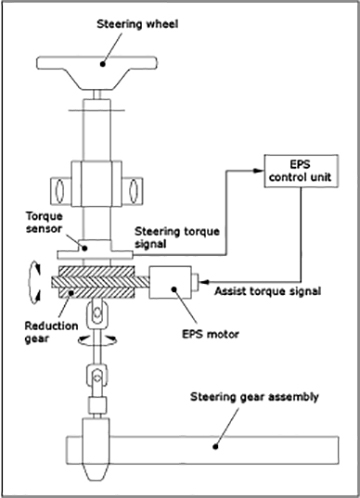
While overload protection control is activated, assist torque gradually decreases and the steering wheel turning force becomes heavy. Assist torque returns to normal if the steering wheel is not turned for a while.
The steering angle sensor requires a neutral position calibration after the following service procedures:
- ABS/VDC electronic control unit replacement
- ABS/VDC electronic control unit replacement
- Replacement of the steering angle sensor
- Removal/installation of steering components
- Replacement of steering components
- Removal/installation of suspension components
- Replacement of suspension components
- Performing wheel alignment
CHASSIS CONTROL TECHNOLOGIES
New chassis control technologies provide visual indicators using the Vehicle Information Display.
The Chassis Control Module (CCM) operates the following systems:
- Active Trace Control
- Active Engine Braking
- Active Ride Control
The following systems are controlled by the ABS/VDC control unit:
- Hill Start Assist
- Advanced Hill Descent Control
Active Trace Control
The Active Trace Control (ATC) function helps to enhance traceability throughout cornering, improving handling. Active Trace Control operates the brakes from commands sent by the Chassis Control Module to the ABS/VDC control unit. The Active Trace Control function controls braking utilizing the ABS actuator, depending on the cornering condition calculated by the wheel speed, steering input and other input data.
The Active Trace Control system utilizes Rogue’s standard Vehicle Dynamic Control (VDC) system to help improve cornering feel. It functions by selectively applying brake pressure to automatically engage the inner or outer brakes to enhance traceability, helping to optimize the line through the turn.
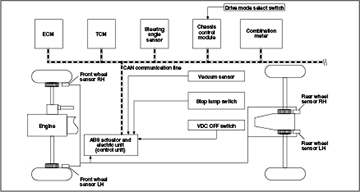
Active Engine Braking
The new CVT (RE0F10D) adds Active Engine Braking, which can vary the CVT drive gear ratios to enhance deceleration in situations such as approaching a curve or slowing to help enhance a stop. Active Engine Braking is the CVT equivalent to what a driver does with a manual gearbox as he or she enters a tight curve - shift down to decelerate smoothly and then shift up again to accelerate through the curve’s apex, which results in smoother cornering. It is also effective in straight-line deceleration, for example slowing down before a red light. With Active Engine Braking, the CVT helps to slow the vehicle as the driver brakes by adjusting torque to slow down the vehicle, resulting in less brake effort by the driver. During a moderate braking operation, the Chassis Control Module requests specific deceleration G-forces via communication with the Transmission Control Module (TCM). The TCM changes CVT gear ratios accordingly. Active Engine Braking assists with deceleration by controlling CVT gear ratio based on the cornering conditions determined from steering input and inputs from various other sensors. It also helps enhance deceleration by controlling gear ratios in the CVT while the vehicle is coming to a stop.
Engine Brake Downshift Adjustment
If a customer makes a complaint like: “I do not feel comfortable with automatic operation of the engine brake on downshift.” The engine brake may be canceled. The Active Engine Brake can be set to ON (enabled) or OFF (disabled) through the Vehicle Information Display “Settings” page. You can use CONSULT/Work Support to perform an adjustment to the engine brake function in the CVT system.
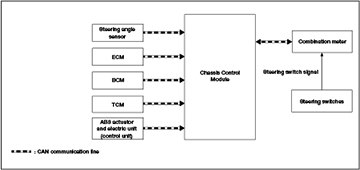
Active Ride Control
Active Ride Control automatically adjusts the throttle and applies brake pressure on rough road surfaces to help enhance ride quality. Active Ride Control works through the Chassis Control Module’s communication with the ECM to adjust engine torque to the front and rear load balance by adding or subtracting engine torque. At the moment the vehicle front is in an upward pitching motion, the engine torque is adjusted minimizing the movement and enhancing ride comfort and handling. It also communicates with the ABS/VDC control unit to control the brake system to apply small amounts of braking to help restrain the vehicle body movement on bumpy roads. It helps to minimize front-to-rear pitch and roll body motion over bumps and dips on rough roads when the vehicle is being driven at speeds over 25 MPH (40 KPH).
Hill Start Assist
Hill Start Assist (HSA) helps limit roll-back when starting on an uphill slope even when the driver’s foot is removed from the brake pedal. When Hill Start Assist is active, it automatically applies the brakes to prevent the vehicle from rolling backward when the vehicle is stopped on an uphill slope. The system holds the brakes for approximately 2 seconds (or until the accelerator pedal is pressed) to limit roll-back.
Hill Descent Control (Rogue T32 4WD models)
Hill Descent Control (HDC) helps the driver maintain a controlled speed without having to use the brakes when going down steep slopes. Advanced Hill Descent Control assists by controlling the vehicle speed, allowing the driver to concentrate on steering the vehicle.
WHEELS AND TIRES
S and SV models have standard 17-inch wheels and tires (S has steel wheels; SV has aluminum-alloy wheels). SL has standard 18-inch aluminum-alloy wheels and tires.
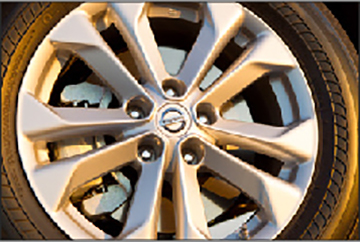
Tire Pressure Monitoring System (TPMS)
The new TPMS on the Rogue (T32) monitors real-time tire pressures and transmits the pressure readings for each tire. At speeds of 25 MPH (40 KPH) or greater, the ABS actuator and electric unit (control unit) receives a detected air pressure signal transmitted by the tire pressure sensors installed in each wheel. The ABS control unit transmits the air pressure signal from each wheel via CAN communication and the Vehicle speed signal (ABS) to the BCM. In addition, the BCM also uses the outside key antennas (driver side, passenger side and rear bumper) to identify the location of the tire pressure sensors. If the BCM receives a low tire pressure or a system malfunction, it sends a signal to the Combination Meter via the CAN communication network and illuminates the low tire pressure warning lamp and a warning message on the Vehicle Information Display.
Easy Fill Tire Alert Function
The TPMS is equipped with the Easy Fill Tire Alert Function that informs the customer with visual and audible indicators when the recommended cold tire pressure has been reached. For Easy Fill to operate, the ignition must be ON with the transmission select lever in the P (Park) position. The hazard warning lamps blink during tire inflation. The horn honks once and the hazard warning lamps stop blinking when the recommended cold tire pressure is reached. The horn honks three times and hazard warning lamps flash when the tire pressure exceeds 4 psi (0.31 kg/cm2) above the recommended pressure.
The Signal Tech II can be used in conjunction with C-III plus, or in TPMS Check Mode without C-III plus for registration of the TPM sensors. A Signal Tech II software update must be performed to ensure it is compatible with the 2014 Rogue (T32).
Run-flat tires (Optional on S and SV)
Run-flat tires are standard on vehicles equipped with optional 3 rd-row seating. Run-flat tires use reinforced sidewalls that can support vehicle weight without any air pressure for a limited amount of time/distance while the vehicle is driven to a repair facility. The spare tire is only available as an option on vehicles equipped with run-flat tires.
EXTERIOR
The 2014 Rogue’s all-new exterior styling provides a compact overall size while still providing ample interior roominess, thanks to its long wheelbase and short front and rear overhangs. The wheelbase has been increased by 0.6 inches, the overall height increased by 1.2 inches and the front overhang reduced by 1.5 inches versus the previous generation Rogue. In addition, the rear doors have been designed with a wider opening (77 degrees), providing easier entry and exit to the rear passenger space. Rogue’s aggressive stance is provided by large wheel wells and available 18-inch wheels and tires. The new Rogue’s coefficient of drag has been reduced by about 10 percent from the previous generation to 0.33. Better aerodynamics and improved coefficient of drag are achieved by optimizing the A-pillar section and outside mirror shapes, which also helps reduce wind noise. The turbulence behind the body has been reduced through optimization of the rear roof spoiler, rear side spoiler and rear combination lights. The Rogue has also been fitted with underbody aerodynamic devices which include a Nissan-first muffler spoiler, a rear bumper closing panel, a fuel tank deflector, rear suspension cover, engine under cover and front tire deflectors.
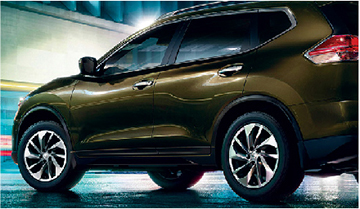
Additional sound absorption materials are used in the wheel wells and other chassis locations to help reduce noise at idle, during acceleration and at highway speeds.
Smart Auto Headlights (SV, SL)
Exterior highlights include standard halogen headlights with LED Daytime Running Lights that automatically switch on when the ignition is turned on.
The system automatically turns the headlights and taillights ON or OFF as it senses changes in natural light. To avoid unnecessary triggering of the headlights in shade from trees and underpasses, the smart ON/OFF system responds to various lighting situations. It also adjusts the instrument panel illumination so the gauges remain easy-to-read regardless of ambient lighting conditions.
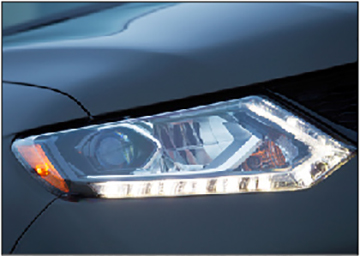
In addition, the headlights turn on automatically after the windshield wipers have made four passes over the windshield.
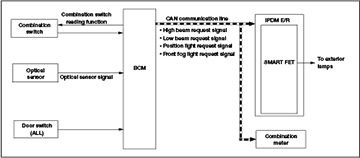
Also available are LED auto-leveling headlights (standard on SL).
The auto-leveling headlights are controlled by the auto levelizer control unit which detects the vehicle condition necessary for the aiming motor control with signals from the rear height sensors. The IPDM E/R calculates vehicle pitch angle from the rear height sensor signals and determines the necessary correction to compensate for any deviation from the standard light axis position. The IPDM E/R then outputs an aiming motor drive signal when operating conditions are met. The headlamp aiming motor moves the headlamps up or down.
NOTE: The auto-leveling feature will adjust the headlight beam height depending on passenger and cargo load.

The LED low- and high-beam headlights not only provide a distinctive look, but more importantly they require less electrical power and last significantly longer than conventional light bulbs.
Also available are fog lights (now standard on SL and available on the SV).
Refer to the Fog Lamp Aiming Adjustment Procedure in the ESM to aim the front fog lamps.
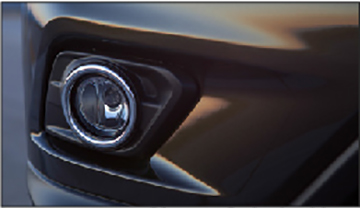
Power Panoramic Moonroof (Optional on SV and SL)
Rogue’s available power panoramic moonroof offers a panoramic view through its extended length. The Panoramic Moonroof consists of: power/tilt front moonroof glass, fixed rear moonroof glass and power sunshade. The front glass panel slides and tilts while the rear glass panel is fixed. When in the open position, the front panel slides under the fixed second panel. The power sunshade retracts to reveal both panels. The moonroof auto-reverse function is operational for a period of time even after the ignition switch is placed in the OFF position. If the front driver’s door or front passenger’s door is opened during this period of time, the power to the moonroof is canceled.
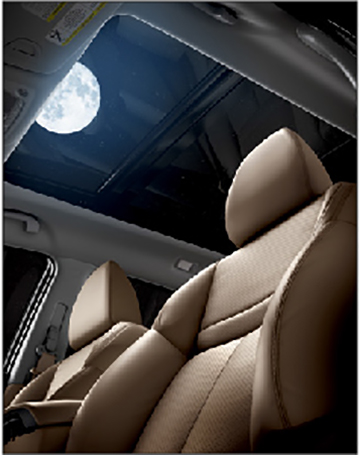
NOTE:
The Power Panoramic Moonroof auto-reverse function initialization must be performed after the following service procedures:
- Body Control Module is replaced
- Any Power Panoramic Moonroof component is replaced
- Moonroof does not open or close automatically after removal/installation
- If the vehicle’s battery is disconnected, replaced or jump started
Initialization can be performed by manual operation of the moonroof and does not require CONSULT.
Power liftgate (SL; optional on SV)
The power liftgate motors are integrated into the liftgate strut assemblies to optimize cabin space and aesthetics. The power liftgate opens with the press of a switch, but before the liftgate opens or closes, a chime signals that the liftgate is about to move. When the liftgate is lowered, the spindle motor closes the back door to the half-latch position then the back door closure motor closes it to the full-latch position. Garage mode allows setting the liftgate to open only to a user-selected height for use in lowclearance situations.
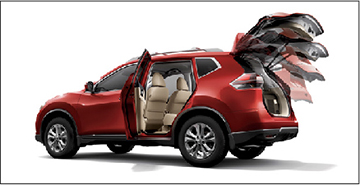
The power liftgate system can be operated using the:
- Power liftgate switch (on dashboard switch bank)
- Power liftgate trim panel switch (on liftgate interior trim)
- Exterior power liftgate handle pressure switch
- Intelligent Key Power Liftgate button
NOTE:
The power liftgate is equipped with a temporary stop function that temporarily stops the open/close operation when:
- The power liftgate trim panel switch is depressed during power liftgate open/close operation.
- The Power Liftgate Disabling Switch is switched to OFF during open/close operation.
INTERIOR
The 2014 Rogue’s all-new interior design offers interior fit, finish and materials that enhance its premium appeal with improved roominess (versus the previous generation Rogue). Key interior styling features include the optimized front headrest shape, lowered front seat shoulder height and forward-shifted center console location. Rogue offers 37.9 inches of 2nd-row legroom with 9.0 inches of fore/aft adjustability. As a result, Rogue features ample interior roominess and 70.0 cubic feet of cargo room (rear seats folded down).
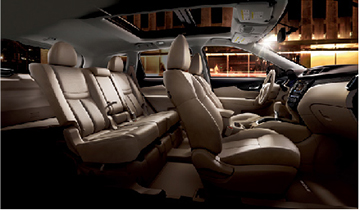
The Rogue’s standard front bucket seats are special zero gravity-inspired by NASA design. Similar to the Nissan Altima’s front seats, the articulated seat shape provides continuous support from the pelvis to the chest, helping to reduce fatigue over long periods behind the wheel.
The front-seat Quick Comfort™ Seat Heater (SL) design provides four heating elements in the seats optimized by seat parts. The knees and the posterior areas warm up more quickly in the initial stage of heater activation for enhanced comfort. The Quick Comfort™ heated front seats are designed to immediately begin warming the body parts that are most sensitive to heat. Then, once the temperature has stabilized, the concentrated heater lines for the hips and thighs are heated to maintain a warm, cozy feeling, as the heater increases heating on body pressure points. This design achieves a temperature balance without adding additional controls by shortening the time between activation of the heater and when the passenger feels warm by 30%. The driver’s seat is 6-way adjustable with available power adjustment, including lumbar support, while the front passenger’s seat is 4-way adjustable.
The versatile Rogue’s innovative EZ Flex™ Seating System provides many interior space options for maximum configuration. The front passenger seat folds rearward, allowing transport of long items, such as an 8-foot ladder, when combined with the flat folding 40/20/40-split 2nd-row seat. The 40/20/40 split seatback design includes a middle seatback that folds forward, creating a convenient pass-through to the cargo area for storing long cargo without sacrificing the outboard seating positions. The optional stadium-style, flat-fold 3rd-row 50/50-split bench seat enhances Rogue’s outstanding passenger versatility. The seatback head restraints can also be lowered for better space utilization when the seatbacks are folded flat.
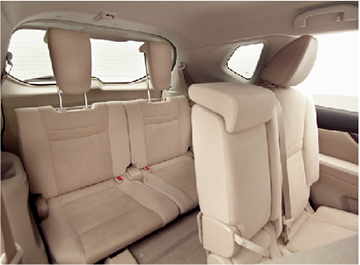
NOTE: The Rogue’s interior has been built with high standards of fit specifications. If it becomes necessary to remove any finisher parts when making repairs on the applicable vehicle, refer to the Fit and Finish article on the Rogue (T32).
DIVIDE-N-HIDE® CARGO SYSTEM
Two separate floor panels in the cargo area can be raised, lowered, set on end and folded to provide cargo-carrying flexibility and security. Up to 18 different configurations are possible.
NOTE: The system is not available on vehicles equipped with the Family Package (3-row seating).
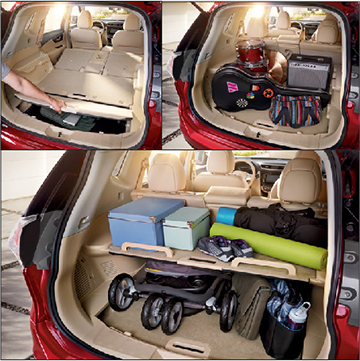
COMFORT AND CONVENIENCE
The steering column now has telescopic steering wheel adjustment which allows the driver to adjust the steering column fore and aft as well as up and down.
Advanced Drive-Assist™ Display
The new Rogue is equipped with a customizable 5-inch TFT color display in the center of the instrument gauge cluster that provides the driver easy recognition of vehicle information and warnings. On vehicles with Navigation, the display shows turn-by-turn navigation guidance, if a destination is set, or a compass direction.
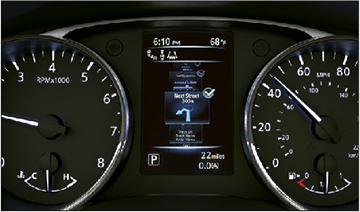
Air conditioning with separate dual-zone climate controls (SV, SL) allows the driver and front passenger to individually establish their own temperature settings. It comes standard with microfilter and adjustable 2nd-row vents.
All Rogues now have three 12-volt power outlets: lower front dash, center console storage compartment and on the side of the cargo area.
Sun visor rod-type extensions allow the sun visors to slide back and forth to help block glare.
Nissan Intelligent Key® with Push Button Ignition is standard on the SV and SL models.
AUTO ACCESSORY
With the vehicle in the P (Park) position and the Intelligent Key in the vehicle, when the ignition is pushed from ON to OFF, the radio can still be used for a period of time or until the driver’s door is opened. During that period of time, functions such as radio, Navigation and Bluetooth® Hands-free Phone System may be restarted by pressing the “POWER button/ VOLUME control knob” or the keyfob unlock button for up to a total of 30 minutes.
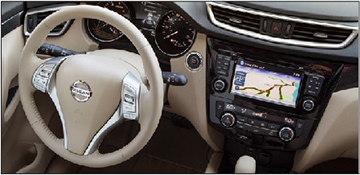
3-Blink Signal Flasher
This feature makes it easier for drivers to signal their intention in situations where they do not want to signal continuously such as when signaling a lane change. When moving the turn signal lever up or down to the point where the indicator light begins to flash but the lever does not latch, the turn signals will flash three times automatically and then stop.
Reverse-Linking Rear Wiper
This feature eliminates the need to turn on both the front windshield wipers and the rear wiper when backing up. When the windshield wipers are turned on, this feature automatically activates the rear wiper when the transmission shifts into Reverse.
CONNECTED TECHNOLOGY
The Bluetooth® Hands-free Phone System is now standard on all Rogues.
All Rogues now have Bluetooth® Hands-free Text Messaging Assistant. The system translates texts from compatible cellular phones to voice messages and allows users to send preset responses.
Available Rogue technology and smartphone integration include NissanConnect™ with Navigation + NissanConnect™ Apps (SL; optional on SV). NissanConnect™ is an information service provided to the customer through data communication functions built into the head unit to provide a variety of services, including:
- USB port connectivity
- Radio/music and social apps
- SiriusXM® Satellite Radio and data services
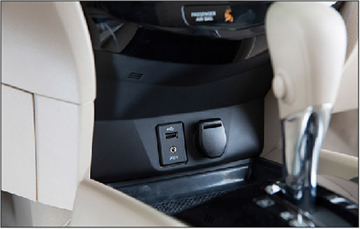
NOTE: For vehicles with Navigation, Apple iPhones® REQUIRE the phone to be plugged in via USB for NissanConnect™ Apps to function. For veh icles without Navigation, Apple iPhones® must be paired via Bluetooth® for NissanConnect™ Apps to function.
A compatible smartphone and registration is required to use mobile applications or to access connected features of certain vehicle applications.
The Navigation System adds the following features to those provided by NissanConnect™ + NissanConnect Apps™:
- 7-inch color touch-screen display
- Advanced Drive-Assist™ Display route guidance
- Curve warnings
- Over-speed warnings
- Lane Guidance
- Voice Recognition
- Point of Interest apps
- SiriusXM Traffic
- SiriusXM Travel Link®
- EcoRoute
NOTE: When reconfiguring Navigation-equipped vehicles with CONSULT-III plus for any reason, the ignition must be cycled two times to complete the configuration.
If the configuration has not completed, some of the symptoms that may occur are:
- No back up camera
- No steering wheel switch response to audio inputs
- No volume response from volume knob
- Volume very loud or very quiet and adjustment is overly sensitive
- Equalizer is adjusted so that Bass control is at maximum all the time
- DTC U1000 for AVM C/U could be present
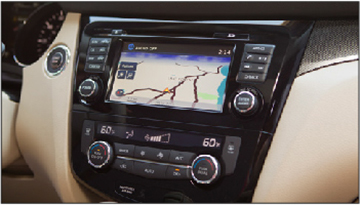
AUDIO SYSTEMS
Several revisions were made to upgrade and enhance the quality of Rogue’s audio systems. The base system has a larger 5-inch color display screen (S, SV) with 4-speaker AM/FM/CD audio system with auxiliary audio input jack. The Bose® audio system now has a 7-inch WVGA touch-panel display, an AM/FM electronic tuner radio, CD drive and navigation unit that are integrated into the AV control unit. Steering-wheel-mounted audio controls and a USB port are now standard on all models. Music files stored in iPod®/USB memory can be played using the separate USB interface. Streaming audio via Bluetooth® and Hands-free Text Messaging Assistant have been added to all models.
When a compatible external storage device is plugged into the AUX jack, compatible audio files on the storage device can be played through the vehicle’s audio system.
SAFETY FEATURES
Around View® Monitor (AVM) with Moving Object Detection (MOD) system (optional on SV and SL) utilizes four small super wide-angle cameras mounted on the front, side and rear of the vehicle to provide a “bird’s eye” virtual 360° view of objects around the vehicle. It provides additional selectable split-screen close-ups of the front, rear and curb views on the audio unit touch-screen, helping the driver maneuver the car in or out of tight spots. The Around View® Monitor control unit is installed behind the glove box. Vehicle width guide lines, predicted course line, vehicle front guide line and vehicle side line, and a vehicle icon are displayed and combined with camera images.
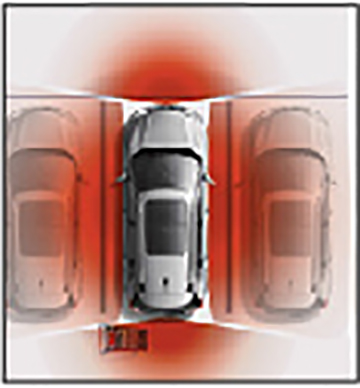
Moving Object Detection provides visual and audible warnings if a moving object is detected within the displayed Around View® Monitor image. The system detects moving objects within the “top view” image when the vehicle is in Park. It detects certain moving objects crossing within the front or rear views when the shift lever is in Drive or Reverse. It is included in the Premium Package.
Other Rogue Safety Shield technologies include Lane Departure Warning (LDW), Blind Spot Warning (BSW), and it is the first Nissan vehicle offering Forward Collision Warning (FCW).
Lane Departure Warning (optional on SV and SL)
An audible tone and instrument panel light help alert the driver to movement of the vehicle out of its travel lane. It is included in the Premium Package.
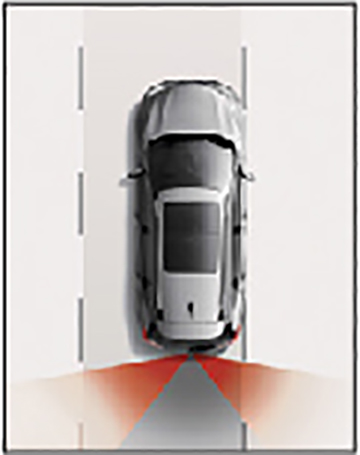
Blind Spot Warning (optional on SV and SL)
Blind Spot Warning (BSW) uses an indicator light located near each A-pillar that illuminates to alert the driver if another vehicle is detected in the blind spot area in an adjacent lane. If the driver then activates the turn signal, the indicator flashes and an audible warning will sound. BSW is included in the Premium Package.
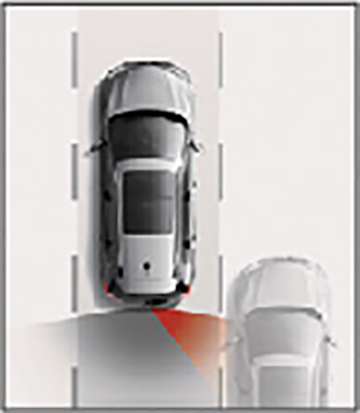
Forward Collision Warning (optional on SL)
When the Forward Collision Warning (FCW) system judges that the vehicle is getting close to a vehicle ahead in the travel lane, the system warns the driver that a forward collision with another vehicle might occur unless action is taken by the driver. FCW is included in the Premium Package.
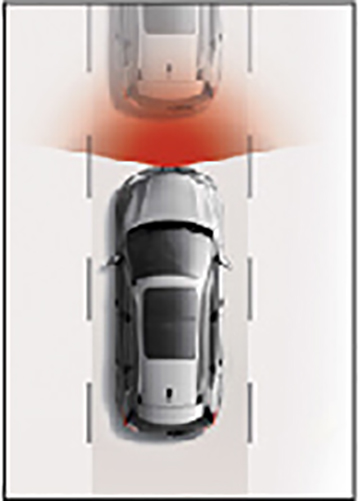
The Distance Sensor is installed on top of the front bumper behind the fascia slightly to right of center. After removal, installation or replacement of the Distance Sensor, perform the following service:
- Distance Sensor initial vertical alignment (mechanical vertical alignment)
- Distance Sensor calibration alignment (electronic horizontal alignment using: CONSULT-III plus, the Hunter Self-centering Wheel Adaptor, the ICC Alignment Kit (1-20-2721-1-IF) and the Aluminum ICC Target Adapter (J-50808).
Nissan Advanced Air Bag System (AABS)
The Rogue vehicle is equipped with the Nissan Advanced Air Bag System for the driver and front passenger seats. The NISSAN Advanced Air Bag System has dual stage inflators. The front air bags, side air bags and curtain air bags operate only when the ignition switch is placed in the ON position. When maintenance work is required on the vehicle, the location of the front air bags, side air bags, curtain air bags, pretensioners and related parts need to first be identified by the person performing the maintenance. The ignition switch should always be in the LOCK position when working under the hood or inside the vehicle.